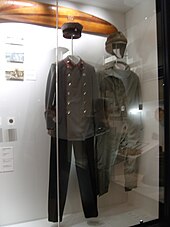Litevka
The Litewka ( Polish : the Lithuanian ) is a double-breasted, tunic-like uniform jacket .
Prussia
It was worn for the first time in Prussia in 1807 by members of the Freikorps of Major Friedrich August Ludwig von der Marwitz . In 1813 it was introduced for large parts of the Prussian Landwehr . While it was mostly born there only by the teams, while the officers usually the Kolett preferred line troops, the militia uniform was popular on the line troops Litewka with the officers of the whole army as interim uniform for approximation.
The Litewka often had long laps and could either be buttoned or closed with concealed hooks and eyes .
The name of the popular piece of uniform remained in the Prussian army even after its abolition. In stories and anecdotes from the period between 1870 and 1914, but also in the literature that emerged from the First World War , this term can be found repeatedly as a term for light overskirts.
From 1893 the use of angle braids came into use. Instead of the usual rank badges on the left upper arm of the Litewka, the open angles of private and non-commissioned officers were worn as follows:
-
Private: a corner of the cloth;
 Litewka of the pilot Max Immelmann
Litewka of the pilot Max Immelmann - NCO: a metal braid;
- Sergeant: two corner braids, the outer one being a metal braid, the inner one a cloth corner;
- Vice Sergeant: two metal angle braids;
- Sergeant: three metal angle braids.
Police in the German Empire
From 1903 Litewken were also in the Prussian police carried as in other German Gendarmerien because the tunic had proved impractical in normal service. Furthermore, Litewken were carried by the protection teams in cities. According to a Hessian ordinance of November 23, 1901, this consisted of dark blue serge , had a stand-up collar, six horn buttons under a concealed button placket and six horn buttons sewn on blindly. Then there were armpit flaps and lugs in indigo blue, two lap pockets and service numbers.
Colonial troops
Different colored Litewken z. B. in blue, gray and khaki were also used from around 1900 in the protection forces , the East Asian Expeditionary Corps in China on the occasion of the Boxer Rebellion and in the marine infantry .
Other uses
Even today the uniform-like society jacket of the carnival societies is referred to as litewka in the Rhenish Carnival . Some societies wear rank insignia as shoulder pieces, others wear them as symbols on their lapels.
literature
- Walter Transfeldt: Word and Custom in Army and Fleet . Edited by Hans-Peter Stein. 9., revised. u. exp. Stuttgart: Spemann, 1986. ISBN 3-440-81060-7 .
- Ingo Löhken: Police Uniforms of the South German States 1872-1932. Baden, Bavaria, Hesse, Württemberg, Reichslande , Friedberg / H. (Podzun-Pallas) 1988. ISBN 978-3-7909-0328-7 . ISBN 3-7909-0328-0
Web links
Individual evidence
- ↑ see also: Ranks of the German Army (German Empire)
- ↑ See Peter Fuchs: Cologne Carnival: its customs, its actors, its history: 175 years of the festival committee of the Cologne Carnival of 1823 eV Cologne: Greven 1997 ISBN 9783774303034



